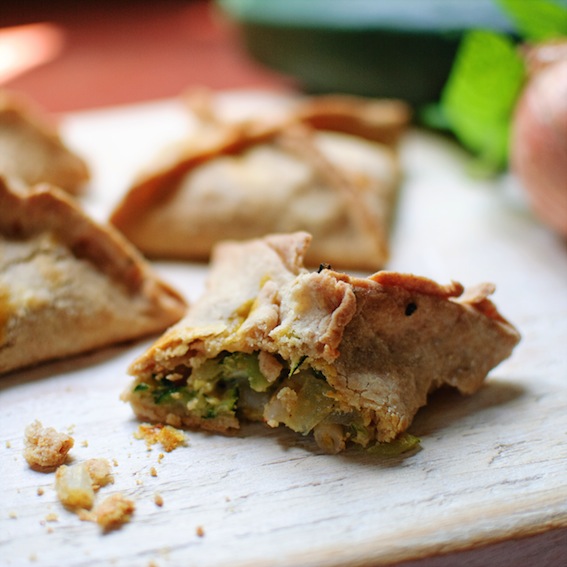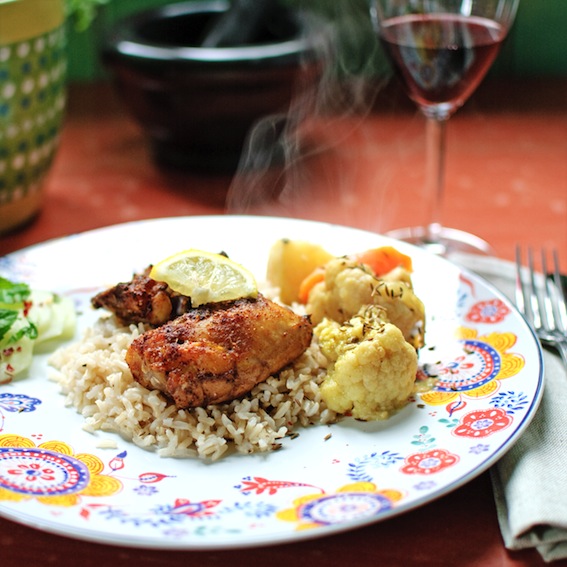-
Potassium, your invisible friend
An excellent and informative post from Dr Malcolm Kendrick, Author of ‘The Great Cholesterol Con’.
-
Mini salmon terrines and getaway strategies
It’s starting to be tricky to escape in the car alone; Motoring is Hugo’s absolute favourite. He prefers the front seat and I have, in the past, resorted to belting him in rather than take on the chore of coaxing him out of the car. Naturally, he takes it very badly if I kick him out. If, on the other hand, I leave him in the car and need to stop off somewhere, he presses on the horn with his chest if he feels I’ve ‘abandoned’ him for too long. He also dribbles on the seat. So it’s a toss-up between his being put-out and potentially depressed at being ditched, and my being mortally embarrassed by a high-maintenance, disruptive dog and wet front seat. I’m spoilt for choice.
This salmon terrine is an attempt to recreate a dish we had in our hotel in the Pyrenees this winter, as requested by Léo. It is, according to him, ‘quite edible’; Praise indeed. 🙂
Ingredients (makes 6 mini terrines)
2 salmon filets (250g)
juice of half a lemon
25g butter
150ml cream
1 clove garlic, crushed
1 shallot, chopped
½ teaspoon ginger, freshly grated
1 bay leaf
1 tablespoon Pastis
sea salt and freshly ground black pepper
1 teaspoon paprika
4 tablespoons of diced cucumber
4 leaves of fresh mint
2g Agar-Agar powder
Place the salmon filets steeped in lemon juice in a frying pan and add the butter and cream. Bring to a gentle simmer and add all the other ingredients with the exception of the Agar-Agar, cucumber and mint leaves. Simmer for about 10 minutes, until the salmon is cooked through and the liquid partly evaporated. Once cooked, add the mint leaves, blend briefly in a food processor and set aside. Dissolve the Agar-Agar in a small amount of water and bring to the boil (according to the instructions on the packet). Once boiled, mix into the salmon with the diced cucumber and distribute the mixture into moulds (I used silicon muffin moulds). Compact the mixture well. Refrigerate for at least a couple of hours and serve chilled.
-
Canelés de Bordeaux
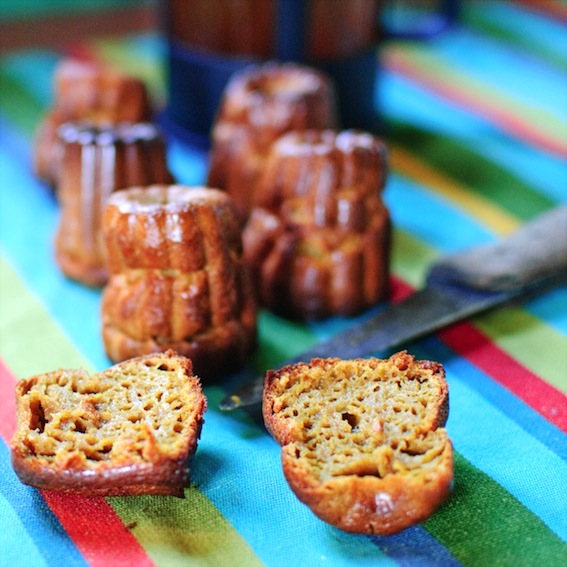
There is an exquisite patisserie called Pariès in Bayonne, which is the capital of the Basque country in south-western France. They recently produced a book of their recipes, which Idrooled overdiscovered the other day. Bayonne is famous for its chocolate, amongst other things, and was one of the first places in Europe to produce chocolate in the early 17th century. There is always a deliciously rich, chocolate-laden aroma in the streets of the city centre. It’s sometimes worth just strolling around there to get a fix!
I will be sharing some of the chocolate recipes from this absolute gem of a book, but today I made another regional speciality: canelé [kan-ul-ay]. A canelé (or cannelé) is a small French pastry with a moist custard-like centre and a dark, thick caramelized crust. It is the shape of a striated cylinder approximately 5 cms in height and is a specialty of Bordeaux.
These contain too much sugar for me to claim that they’re positively good for you. Having said that, I made them with cane sugar and spelt flour (of course!) and as they contain rich, ‘real’ ingredients they are most definitely a healthier choice as a treat than anything in packaging! I had to make a second batch to photograph because the first batch disappeared far too quickly; They’re that moreish!
Ingredients (makes about 12)
You will need a special canelé mould to make these. The best are made from copper, although I used silicon.
400ml milk
20g salted butter
2 egg yolks
1 egg
140g sugar (I used cane sugar)
120g flour (I used spelt flour)
1 vanilla pod
10cl rum
A little extra butter for greasing the moulds
Beat the egg yolks, egg and sugar in a mixing bowl. Add the flour and vanilla and continue to mix gently. Bring the milk to the boil in a saucepan, remove from the heat and immediately add the butter. When the milk has cooled to lukewarm, add to the other ingredients in the mixing bowl. Mix well. Leave the mixture to rest in the fridge for at least 24 hours, 48 hours if possible. This is important as the mixture must be as ‘airless’ as possible or it will rise during cooking. Also for this reason, it must always be mixed gently, taking care not to add too much air.
To cook the canelés, preheat the oven to 220°C. Remove the mixture from the fridge and very gently stir the (what will now be separated) batter until homogenous. Add the rum at this stage too. Fill the buttered moulds about 7/8 full. Cook for 10 minutes at 220°C and then turn the oven down to 190°C. Cook for a further 40 minutes. Leave to cool before eating. -
Spelt flour pizza base and stark-raving lunatics

The moon is full tonight. If you have animals anything like ours and had intended sleeping through the night, a word of warning: it ain’t gonna happen. 🙂
The horses will spend all night ‘partying’ (galloping from one end of the field to the other, whinnying to anyone who will listen and ‘fighting’ on their hind legs). They’ll be exhausted by the morning (thank God) and spend the whole day sleeping it off.
The hens are, at his very moment, on the terrace table doing a sort of flamboyant chicken tango, which involves much flapping, flirting, fluttering and hissing. In fact it’s so flamboyant that one of them fell off the table *snigger*.
Which bring me to Hugo. Being a bit of a primo uomo, Hugo makes sure that his behaviour trumps that of the other animals. Having pulled his chair away from the wall with his teeth, he has created a little game for himself. He charges the chair, throwing himself into it heavily to see how far it will ‘skid’ across the tiles. After several good ‘skids’, he runs dementedly around the house, blanket over head, seeking praise for his talent. Just shoot me now.
There are times when only pizza will do. This base, being made from spelt flour, is light, tasty, nutritious and more easily digested than a regular pizza base.
Ingredients (6 slices)
250g spelt flour
½ teaspoon salt
1 tablespoon olive oil
1 sachet bakers yeast (dilute in lukewarm water 10 minutes before use)
pinch of bicarbonate of soda
Sift the flour and salt into a mixing bowl. Beat or knead for about 6 minutes, progressively adding a tiny bit of water, teaspoon by teaspoon. Be careful not to add too much water or the dough will become sticky. Leave the dough to rise at a temperature of 25°C to 35°C for an hour, then re-mix (or re-knead). Put it in the fridge for an about an hour and then roll out ready to apply the topping. I used fresh tomato sauce, black olives, chorizo, anchovies and parmesan. Cook in a preheated oven (200°C) for 15-20 minutes. -
Savoury chickpea pastry parcels and dog walking, matador-style
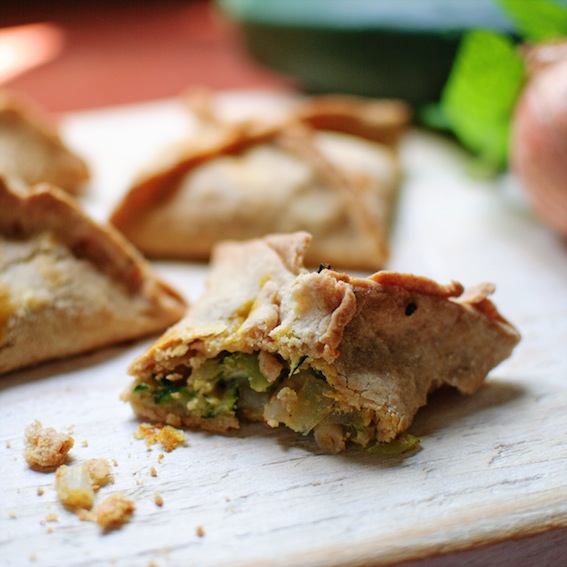
If you ever happen to be in the ‘Landes’ forest and spot someone dressed in full body armour, brandishing a big red cape, matador-style, that’ll be me. Hugo’s 30 kilos of muscular dynamisn, a by-product of daily triathlon training, plus an ardent passion for ‘walkies’ have become a mortal combination. He charges back and forth like a bull, playing ‘chicken’ with my unsuspecting shins and leaving it to the very last possible second to swerve to avoid them (or not as the case may be!) He also grabs my shoes in his jaws, willing them to move faster. I’ve been knocked flying on several occasions, which unfortunately has only ever served as a pretext for much guilt-induced licking which, frankly, I could live without…
These savoury parcels are finger-licking good, as well as being very nutritious and quick and easy to make. They are wheat-free.
Ingredients for chickpea pastry (makes about 4 parcels)
80g spelt flour
50g chickpea flour
50g butter
2 tablespoons olive oil
Pinch of sea salt
Roughly 6 tablespoons of cold water
Ingredients for filling
1 courgette, grated
1 potato, boiled and chopped into cubes
1 onion, chopped
2 cloves garlic, chopped
4 tablespoons parmesan, grated
2 tablespoons pine nuts
6 fresh mint leaves, cut into pieces
Sea salt to taste
1 teaspoon paprika
To make the pastry, begin by cutting the butter and into small cubes. Sift the flours and a pinch of salt together into in a mixing bowl, also adding the cubes of butter. Rub in and blend by hand until the mixture becomes crumbly. Add the olive oil and combine well and then add the cold water, mixing rapidly with a spoon. Remove the mixture from the bowl onto a lightly floured surface. Knead until you obtain a ball of pastry (if the mixture isn’t ‘sticky’ enough to form a ball, you may need a drop more water). Wrap in a clean cotton tea towel or some cling film and leave to ‘rest’ in the fridge for about two hours. This relaxes the dough and makes it easier to use.
To make the filling, combine the ingredients in a bowl, mix well and then press a little with your fingers so that the mixture gains in density.
Preheat the oven to 180°C. Roll the pastry out on a clean, dry, floured surface. Cut into squares of approximately 15cm, put a good tablespoon of mixture into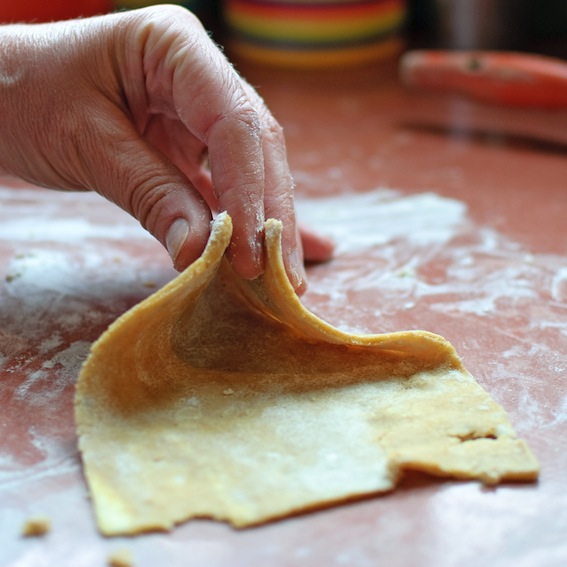 the middle and then fold back the edges to meet in the middle and form a parcel. Press the edges together until the pastry sticks.
the middle and then fold back the edges to meet in the middle and form a parcel. Press the edges together until the pastry sticks.
Place the parcels on a lightly oiled baking tray and cook for 20 minutes. -
Tandoori chicken and shameless squatters

I’ve arrived at the conclusion that our animals need to be brought to heel. When we were first married, someone actually suggested my husband bring me to heel (yes, really :lol:), but don’t let’s go there today. The hens, having been told in no uncertain terms that hoarding is NOT on, have now taken up squatting. I suppose bad habits are never really eradicated, just replaced with other bad habits – they’ll no doubt be smoking and chewing gum next. Unfortunately they are particularly fond of squatting the most comfortable chair on the terrace, the only one we own that doesn’t dig menacingly into your back. Having made Tandoori chicken yesterday, I’m thinking of investing in a Tandoor oven and was wondering whether they would understand the veiled threat 😉 ?

A Tandoor is a cylindrical clay oven, typically found in Central, Western and Southern Asia. The heat source is a wood or charcoal-burning fire and temperatures can reach over 450°C. If you don’t have a Tandoor to hand, obviously a hot regular oven will do.
Ingredients (serves 4)
8 skinless chicken thighs
1 red onion, chopped finely
Juice of 1 lemon
2 tablespoons olive oil
For the marinade :
150ml greek yoghurt
1 piece of fresh ginger, grated
4 garlic cloves, crushed
1 teaspoon cumin seeds
½ teaspoon chilli powder
½ teaspoon paprika
½ teaspoon turmeric
½ teaspoon sea salt
Slash the chicken thighs several times then cover them with the lemon juice and chopped onions. Set aside in a deepish dish. Mix the marinade ingredients together and pour over the chicken, making sure that all bits are well covered. Leave to chill for at least an hour or overnight if possible. Preheat the oven to 220°C. Carefully place the chicken thighs on a lightly oiled baking tray and cook for about 25 minutes, depending on the size of the thighs. They are cooked through properly when the juice runs clear when prodded with a fork. May be served with basmati rice, naan bread, chickpea pancakes (recipe here), or vegetable curry. Delicious with chutney too. -
The fats you need for a healthy diet
I totally agree with this interesting ‘history of fats’…
-
Olive, red pepper and anchovy cake and a volatile hoarder
To follow on from this post, unfortunately our black hen died. Hens seem to be so vulnerable to attack from disease, foxes, dogs and perhaps even other hens. I imagined she was suffering from depression when maybe she was just sad to be sick. 🙁
We were (when I say ‘we’ I suppose I mean ‘I’ as, unlike me, neither husband nor son obsesses about our animals) rather worried about the white hen who had disappeared suddenly. We eventually found her over a week later under two enormous bales of hay in a little-used barn, sitting on no fewer than 23 eggs; The little minx had obviously been hiding, laying and hoarding! Don’t ever let it be said that hens can’t multitask. So to add to our animals’ extensive list of mental disorders, we now appear to be the proud owners of a compulsively hoarding hen. Can anyone tell me where I can get my hands on an animal that doesn’t have ‘issues’?
This savoury cake is based on an old French recipe and goes beautifully with soup or hors d’oeuvres. It’s quite light and crumbly and, being made with spelt flour, healthy, wheat-free and low GI.
Ingredients
175g spelt flour
1 teaspoon baking powder
1 teaspoon bicarbonate of soda
1 teaspoon paprika
1 pot of yoghurt (125g)
3 organic eggs, beaten
100ml olive oil
50g red pepper, finely chopped
40g black olives, stones removed
50g sun dried tomatoes
6 anchovies
Preheat the oven to 180°C. Combine the flour, baking powder, bicarbonate of soda and paprika and add the eggs and yoghurt, mixing well. Continue mixing and add the olive oil until you obtain a homogenous paste. Stir in the other ingredients and once well combined, spoon the mixture into a medium-sized, oiled loaf tin. Cook for about 40 minutes, or until a fork comes out clean.
-
Spelt flour crêpes and the chaos theory according to Hugo
by Hugo, Canine CorrespondentIn the interests of transparency (have you noticed the trendy lingo I’m picking up?), I asked to write today’s blog because I don’t think that the Bossy One is always very honest with you.
The way she presents her recipes would have you believe that she’s a domestic goddess (I heard that on the television), when in fact, nothing could be further from the truth. The havoc she creates in the kitchen is quite something. Not that I’m not complaining because the more the food ends up on the floor, the happier I am. 🙂
Today’s recipe, for example, should really read something like this:
Sift the flour, salt and bicarbonate of soda into a mixing bowl, use a large shovel to scoop up the ingredients that somehow landed outside the bowl, whilst simultaneously trying to recover from violent coughing and sneezing fit caused by inhaled flour. Make a well in the centre and break the eggs into it, mutter obscenities and pick the broken bits of eggshell out with your fingernails. Whisk the eggs, little by little incorporating the surrounding flour. If you use an electric whisk, you can be sure that a substantial amount of mixture will end up on the surrounding walls, sometimes even the ceiling. Combine the almond milk and water and add little by little to the flour/egg mixture. Turn the whisk to SLOW before pouring in liquid, otherwise it will ricochet alarmingly which isn’t good because it causes more mad muttering (I can also do alliteration :-)). Once all the liquid has been added, continue to whisk until you obtain a smooth batter, the consistency of thin cream (yeah right; in her dreams!). Push back messy hair, smothering small amount of ‘smooth’ ( 😆 ) batter over face.
I won’t go on because she can be a bit sensitive when it comes to criticism, even if it is constructive, and I’d like to continue this writing lark. I will leave you with this thought though: this is a simple recipe – just imagine the scenario with a complicated one 😉

Thank you for your kind words Hugo, I think I’ll take over now. This is based on Delia Smith’s recipe for ‘basic pancakes’, which I have adapted to use with spelt flour and almond milk.
Ingredients (makes about 10 crêpes)
110g spelt flour
pinch of salt
pinch of bicarbonate of soda
2 large eggs
200ml almond milk
75ml water
butter or coconut oil for cooking
Sift the flour, salt and bicarbonate of soda into a mixing bowl, make a well in the centre and break the eggs into it. Whisk the eggs, little by little incorporating the surrounding flour. Combine the almond milk and water and add little by little to the flour/egg mixture. Once all the liquid has been added, continue to whisk until you obtain a smooth batter, the consistency of thin cream.
To cook the crêpes you will need a shallow frying, or preferably a crêpe pan. Melt the butter or coconut oil making sure that the base of the frying pan is coated. Pour a small amount of batter into hot fat in the pan, tipping from side to side to distribute evenly. Cook until golden brown on both sides.

-
Vegetable couscous and crestfallen hens

As if a deeply neurotic dog isn’t enough to cope with, I now appear to have a depressed hen on my hands. She’s been a bit down in the beak since the arrival of the young louts and has taken to spending time alone, presumably heeding the French adage ‘Il vaut mieux être seul que mal accompagné’ (it’s better to be alone than badly accompanied). I’m a dab hand at dealing with dippy horses (two headcollars ripped to shreds in under five minutes today; a record even by our standards) and bipolar dogs, but this is somewhat baffling…
I made this vegetable couscous with her in mind as it meant lots of vegetable peelings and some remnents of couscous grain to perk her up a bit. I used spelt couscous which is nutty, subtle and lighter than wheat couscous, but you can use either. I’m a big fan of spelt, an ancient protein-rich grain offering a far broader range of nutrients than wheat (manganese, phosphorus, vitamin B3, magnesium, copper…). It also seems to cause fewer digestive problems than wheat, although it does contain gluten.
Ingredients (serves 4)
2 tablespoons olive oil
4 carrots, peeled and cut into large pieces
1 potato, peeled and cut into large chunks
1 onion, peeled and sliced
4 cloves of garlic, peeled
1 red pepper (sliced)
2 tomatoes (blanched, peeled and sliced)
1 large courgette, cut into approximately 4cm slices
4 baby turnips, peeled
100g pre-cooked chickpeas
1 bay leaf
Sea salt and freshly ground black pepper
3 teaspoons ras-el-hanout
200ml chicken or vegetable stock
200g couscous
handful of raisins
harissa and fresh mint to serve
Fry the onions in the olive oil, gradually adding the other vegetables. Add the seasoning, spices and stock and simmer for about 30 minutes until the vegetables are tender. Prepare the couscous according to instructions, adding the raisins to the boiling water. Serve the couscous and ladle the vegetables and sauce over the top. This is good either on its own or to accompany grilled or barbecued sausages and meat.

